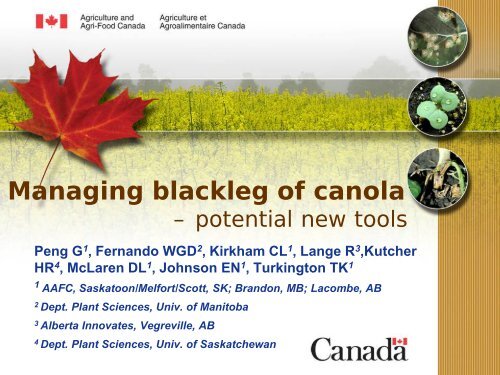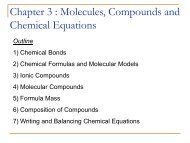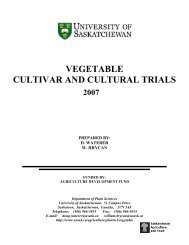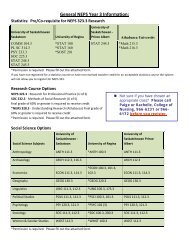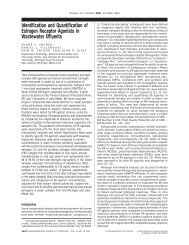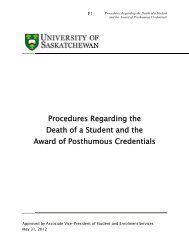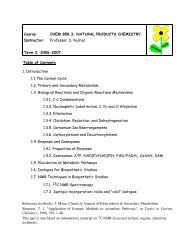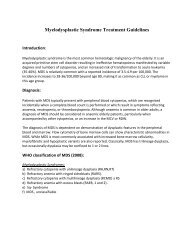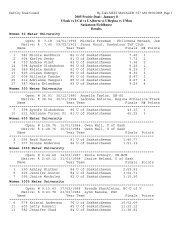Dr. Gary Peng, AAFC – Blackleg - University of Saskatchewan
Dr. Gary Peng, AAFC – Blackleg - University of Saskatchewan
Dr. Gary Peng, AAFC – Blackleg - University of Saskatchewan
You also want an ePaper? Increase the reach of your titles
YUMPU automatically turns print PDFs into web optimized ePapers that Google loves.
Managing blackleg <strong>of</strong> canola<br />
<strong>–</strong> potential new tools<br />
<strong>Peng</strong> G 1 , Fernando WGD 2 , Kirkham CL 1 , Lange R 3 ,Kutcher<br />
HR 4 , McLaren DL 1 , Johnson EN 1 , Turkington TK 1<br />
1 <strong>AAFC</strong>, Saskatoon/Melfort/Scott, SK; Brandon, MB; Lacombe, AB<br />
2 Dept. Plant Sciences, Univ. <strong>of</strong> Manitoba<br />
3 Alberta Innovates, Vegreville, AB<br />
4 Dept. Plant Sciences, Univ. <strong>of</strong> <strong>Saskatchewan</strong>
Background<br />
For many years, blackleg disease <strong>of</strong> canola was<br />
managed effectively with resistant cultivars in<br />
conjunction with 4-yr crop rotation<br />
Leptosphaeria maculans race structure has been<br />
changing, influenced by R genes used in canola<br />
cultivars and environmental conditions<br />
Crop rotation has been tightened in recent years<br />
in favor <strong>of</strong> canola production<br />
<strong>Blackleg</strong> disease is on the rise, more noticeable in<br />
some regions than others on the prairies
<strong>Blackleg</strong> survey in <strong>Saskatchewan</strong> - 2012<br />
Region No. fields<br />
surveyed<br />
% Fields with<br />
<strong>Blackleg</strong><br />
Avg. disease<br />
incidence (%)<br />
NW 54 48 16.6<br />
NE 45 27 8.1<br />
WC 36 14 3.0<br />
EC 61 34 5.0<br />
SW 14 36 6.6<br />
SE 43 30 20.2<br />
Province 253 32 11.2<br />
Data compiled by SK Ministry <strong>of</strong> Agriculture
What factors can influence the<br />
increase <strong>of</strong> blackleg disease?<br />
Pathogen population: <strong>–</strong>race structure. The type &<br />
frequency <strong>of</strong> Avirulent (Av)/avirulent (av) alleles<br />
Resistance genes in canola cultivars (specific &<br />
quantitative resistance genes)<br />
Occurrence Fungicides and their reproduction timing when <strong>of</strong> “new” resistance pathogen<br />
breaks races that down are (worst-case able to overcome scenario) R genes <strong>–</strong> The<br />
rate <strong>of</strong> reproduction would be higher under short<br />
crop rotations
I. LM race structure and dynamics<br />
Pathogen-host interaction (seedling stage)<br />
Specific R gene L. maculans Av gene<br />
Rlm1 Av1<br />
Rlm2 Av2<br />
Rlm3 Av3<br />
Rlm4 Av4<br />
Rlm5,6 Av5,6<br />
Rlm7 Av4<br />
Rlm8 Av8<br />
Rlm9 Av9<br />
Rlm10 Av10<br />
LepR1 AvLep1<br />
LepR2 AvLep2<br />
LepR3 AvLep3<br />
LepR4 AvLep4
LM-canola interaction<br />
Rlm3<br />
Rlm3<br />
AvLm3<br />
avLm3
Perception <strong>of</strong> pathogens by plants -effectors<br />
Av3<br />
Rlm3<br />
PAMPs: Pathogen-associated molecular patterns (extracellular)<br />
PTI: PAMP-triggered immunity<br />
Effector: Pathogen proteins in the host cytoplasm<br />
ETI: Effector-triggered immunity (intra-cellar)<br />
Dodds & Rathjen (2010) Nature Rev. Gen., 11:539-548
A set <strong>of</strong> Brassica lines for differentiating<br />
Av genes in L. maculans<br />
Canola lines R-genes Canola lines R-genes<br />
MT29 Rlm1,9 Falcon MX Rlm4,6<br />
Grizzly Rlm1,3 Darmor MX Rlm6,9<br />
Cooper Rlm1,4 Cutlass Rlm5,6?<br />
Samouraï Rlm2,9 23-2-1 Rlm7<br />
Glacier Rlm2,3 Darmor Rlm9<br />
Verona Rlm2,4 Line 1065 LepR1<br />
22-1-1 Rlm3 Line 1135 LepR2<br />
Falcon Rlm4 Surpass400 Rlm1,LepR3<br />
Replacing the earlier PG system
Assessment <strong>of</strong> L. maculans isolate with host differentials<br />
3<br />
5<br />
0-9 rating scale<br />
7<br />
9
F<br />
r<br />
e<br />
q<br />
u<br />
e<br />
n<br />
c<br />
y<br />
L. maculans race pr<strong>of</strong>ile -2010<br />
100.00%<br />
90.00%<br />
80.00%<br />
70.00%<br />
60.00%<br />
50.00%<br />
40.00%<br />
30.00%<br />
20.00%<br />
10.00%<br />
0.00%<br />
Frequency <strong>of</strong> Av alleles (MB, SK, AB)<br />
1 2 3 4 6 7 9 LepR1 LepR2 LepR3<br />
Av alleles<br />
2007
F<br />
r<br />
e<br />
q<br />
u<br />
e<br />
n<br />
c<br />
y<br />
Regional variation <strong>–</strong>southern MB 2010<br />
100.00%<br />
90.00%<br />
80.00%<br />
70.00%<br />
60.00%<br />
50.00%<br />
40.00%<br />
30.00%<br />
20.00%<br />
10.00%<br />
0.00%<br />
1 2 3 4 6 7 9 LepR1 LepR2 LepR3<br />
Av alleles
F<br />
r<br />
e<br />
q<br />
u<br />
e<br />
n<br />
c<br />
y<br />
Regional variation <strong>–</strong>Vegreville, AB 2010<br />
100.00%<br />
90.00%<br />
80.00%<br />
70.00%<br />
60.00%<br />
50.00%<br />
40.00%<br />
30.00%<br />
20.00%<br />
10.00%<br />
0.00%<br />
1 2 3 4 6 7 9 LepR1 LepR2 LepR3<br />
Av alleles
II. R genes in canola cultivars/lines<br />
A differential set <strong>of</strong> L. maculans isolates<br />
- A total <strong>of</strong> 19 L. maculans isolates with defined Av<br />
genes were employed to determine R genes present<br />
in canola at <strong>Dr</strong>. Fernando’s lab at U <strong>of</strong> M<br />
Canola cultivars/lines<br />
- A collection <strong>of</strong> 87 canola cultivars/lines obtained<br />
from several seed companies, government labs and<br />
other research institutions were characterized based<br />
on seedling inoculation using the differential set <strong>of</strong> L.<br />
maculans isolates.
Av genotypes <strong>of</strong> L. maculans isolates<br />
Isolates AvrLm1 AvrLm2 AvrLm3 AvrLm4 AvrLm5 AvrLm6 AvrLm7 AvrLm8 AvrLm9 AvrLm10 AvrLmS<br />
D1 avr Avr avr avr Avr Avr avr avr Avr nd nd<br />
D2 avr avr avr avr Avr Avr avr Avr avr nd Avr<br />
D3 avr avr avr avr Avr avr avr avr avr nd avr<br />
D4 avr avr avr Avr Avr Avr Avr Avr avr nd avr<br />
D5 Avr Avr avr Avr avr avr Avr avr avr nd Avr<br />
D6 Avr avr avr avr Avr Avr avr Avr avr nd Avr<br />
D7 Avr avr Avr avr Avr Avr avr Avr avr nd nd<br />
D8 avr avr avr avr Avr avr Avr nd avr nd avr<br />
D9 avr avr avr avr Avr Avr Avr nd avr nd avr<br />
D10 avr avr avr avr Avr Avr avr Avr Avr nd Avr<br />
D13 avr avr avr Avr nd Avr Avr nd avr nd avr<br />
D14 Avr avr avr avr nd avr Avr nd avr nd Avr<br />
S7 Avr avr avr avr Avr Avr Avr nd avr avr avr<br />
ICBN14 avr avr avr avr Avr Avr avr avr avr Avr avr<br />
PHW1223 avr avr avr avr Avr Avr avr Avr Avr avr avr<br />
R2 avr avr avr avr Avr avr Avr nd avr Avr avr<br />
AD-746 avr avr Avr avr nd Avr avr nd avr avr avr<br />
JN2 avr avr avr avr Avr Avr Avr Avr avr avr avr<br />
JN3 Avr avr avr Avr Avr Avr Avr Avr avr avr avr
R genes found in 87 canola cvs/lines<br />
80%<br />
70%<br />
60%<br />
50%<br />
40%<br />
30%<br />
20%<br />
10%<br />
0%<br />
Rlm1<br />
Rlm2<br />
Rlm3<br />
Rlm4<br />
Rlm5<br />
Rlm6<br />
Rlm7<br />
Rlm8<br />
Rlm9<br />
Rlm10<br />
Percentage <strong>of</strong> cultivars/lines carrying each R-gene<br />
RlmS<br />
nd
R genes in 87 canola cultivars/lines<br />
70%<br />
60%<br />
50%<br />
40%<br />
30%<br />
20%<br />
10%<br />
0%<br />
1 2<br />
Number <strong>of</strong> R-genes<br />
3 4<br />
Percentage <strong>of</strong> cultivars/lines carrying multiple R-genes
III. Fungicides & application timing<br />
Yield<br />
(bushels/acre)<br />
30<br />
20<br />
10<br />
0<br />
Trials in SK, 2000-2003 (8 site-years)<br />
Azoxystrobin (Quadris)<br />
+14%<br />
Susceptible Resistant<br />
Lsd (0.05)<br />
Fungicide<br />
No Fungicide<br />
By HR Kutcher
New fungicides and application timing<br />
Treatments<br />
On S cultivar (no R-genes)<br />
On MR cultivar (43E01)<br />
1. Non-sprayed control<br />
2. Headline @2-4 leaf stage<br />
1.<br />
2.<br />
Non-treated control<br />
Headline @2-4 leaf stage<br />
On R cultivar (45H29)<br />
3. Quadris @2-4 leaf stage 1. Non-sprayed control<br />
4. Tilt @2-4 leaf stage<br />
2. Headline @2-4 leaf stage<br />
5. Quilt @2-4 leaf stage<br />
6. Headline @just prior to bolting<br />
7. Tilt @2-4 leaf, Headline @pre-bolting<br />
8. Headline @2-4 leaf, Tilt @pre-bolting<br />
All products were applied at label recommended rates
Trial locations: (2011-2014)<br />
black soil zone<br />
dark brown soil zone<br />
brown soil zone<br />
■ Vegreville<br />
■ Lacombe ■ Scott<br />
■ Melfort<br />
■ Brandon<br />
■ Carman
0<br />
1<br />
2<br />
3<br />
4<br />
5<br />
Trial assessment<br />
Disease incidence, severity<br />
were rated at near maturity<br />
Each replicated plots were<br />
harvested separately, seeds<br />
dried, cleaned and the yield<br />
taken for each replicate<br />
Stubbles were left in plots<br />
for initial inoculum in the<br />
following year<br />
New plots seeded adjacent<br />
to the previous plot area
<strong>Blackleg</strong> severity on S cultivar <strong>–</strong>2011 (3 sites)<br />
Treatment Melfort Carman Vegreville<br />
Nontreated control 0.9 1.8 1.5<br />
Headline (2-4 leaf) 0.9 0.4 * 1.2<br />
Quadris (2-4 leaf) 0.9 0.6 * 1.1<br />
Tilt (2-4 leaf) 1.1 2.7 1.4<br />
Quilt (2-4 leaf) 0.5 1.0 1.4<br />
Headline (rosette) 0.9 1.5 1.2<br />
Tilt (2-4 L) + Headline (rosette) 0.6 1.2 1.1<br />
Headline (2-4 L) + Tilt (rosette) 0.6 0.7 * 1.2<br />
* Significant at P=0.05 (Dunnetts’ test)
<strong>Blackleg</strong> severity on S cultivar <strong>–</strong>2012 (5 sites) #<br />
Treatment Brandon Carman Vegreville<br />
Nontreated control 1.9 2.9 3.4<br />
Headline (2-4 leaf) 1.5 0.9 * 2.2 *<br />
Quadris (2-4 leaf) 1.4 1.6 * 1.7 *<br />
Tilt (2-4 leaf) 1.7 2.3 2.5<br />
Quilt (2-4 leaf) 1.5 2.1 1.7 *<br />
Headline (rosette) 2.5 2.3 1.7 *<br />
Tilt (2-4 L) + Headline (rosette) 2.6 2.6 1.7 *<br />
Headline (2-4 L) + Tilt (rosette) 1.5 1.2 * 1.8 *<br />
# The disease severity at Melfort and Scott sites (SK) was
Canola yield (bu/ac)<br />
50<br />
40Trial<br />
2<br />
30<br />
20<br />
10<br />
0<br />
Yield <strong>of</strong> S cultivar was not affected by<br />
fungicide treatments (2011)<br />
Check<br />
Headline (2-4 leaf)<br />
Quadris (2-4 leaf0<br />
Tilt (2-4 leaf)<br />
Carman<br />
Vegreville<br />
Headline (rosette)<br />
Headline (2-4 leaf) + Tilt (rosette)<br />
Tilt (2-4 leaf) + Headline (rosette)<br />
Fungicide treatment<br />
Quilt (2-4 leaf)<br />
No substantial<br />
increase in yield<br />
observed with any<br />
<strong>of</strong> the fungicide<br />
treatments.<br />
High variability<br />
with yield data
Yield (bu/ac) <strong>of</strong> S cultivar was not affected<br />
by fungicide treatments (2012) #<br />
Treatment Brandon Carman Vegreville<br />
Non-treated control 10.6 24.1 21.3<br />
Headline (2-4 leaf) 10.0 25.0 27.6<br />
Quadris (2-4 leaf) 12.7 27.4 23.5<br />
Tilt (2-4 leaf) 9.7 22.7 23.0<br />
Quilt (2-4 leaf) 12.3 33.0 27.5<br />
Headline (rosette) 10.9 28.0 26.9<br />
Tilt (2-4 leaf) + Headline (rosette) 10.5 24.0 25.0<br />
Headline (2-4 leaf) + Tilt (rosette) 11.3 29.1 24.2<br />
# The disease severity at Melfort and Scott sites (SK) was
Fungicides did not improve the yield<br />
(bu/ac) <strong>of</strong> R/MR canola cultivars<br />
(Cultivar) Brandon<br />
Treatment 2012 #<br />
Carman<br />
2011 # Vegreville<br />
2012 2011 2012 #<br />
(45H29 -R)<br />
Nontreated 17.4 62.5 43.9 65.7 47.2<br />
Headline 19.3 54.4 50.9 61.7 44.7<br />
(43E01 -MR)<br />
Nontreated 13.5 42.6 36.8 47.0 36.3<br />
Headline 13.6 38.7 32.1 52.8 30.8<br />
# The fungicide treatment reduced blackleg substantially (Dunnetts’ test, P=0.05)
Summary<br />
Av1, Av3, Av9, AvLep1 & AvLep2 genes showed<br />
low frequencies in the L. maculans population,<br />
so Rlm1, Rlm3, Rlm9, LepR1, & LepR2 genes<br />
are ineffective<br />
Regional variation in Av genes <strong>–</strong>cultivar selection<br />
(if R genes are known)?<br />
Most cultivars/lines carry Rlm3. Other R genes<br />
are rare, showing limited diversity <strong>of</strong> R genes in<br />
canola germplasm<br />
A few lines carry multiple R genes (up to 4)
Summary ……continues<br />
Rotation <strong>of</strong> R genes may be a challenge <strong>–</strong>lack <strong>of</strong><br />
diversity<br />
Quantitative R genes may be important, but poorly<br />
understood<br />
Early spray (2-4 leaf stage) with Headline/Quadris<br />
reduced blackleg 3 out 5 site-years on S cultivar. A<br />
late application (at bolting) would be less effective<br />
None <strong>of</strong> the fungicide treatments increased canola<br />
yield substantially, regardless <strong>of</strong> host resistance
Acknowledgements<br />
Technicians, graduate students, coop students at<br />
<strong>AAFC</strong>, Saskatoon/Melfort/Scott, SK; Brandon, MB;<br />
Lacombe, AB, <strong>University</strong> <strong>of</strong> Manitoba, and Alberta<br />
Innovates provided technical assistance<br />
This study is partially funded by Canola<br />
Council <strong>of</strong> Canada


